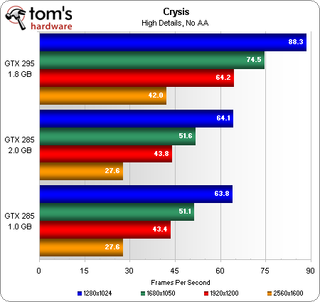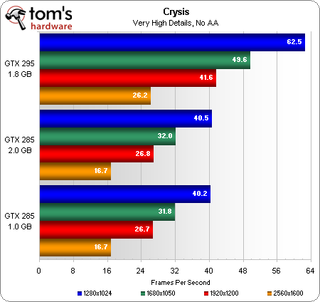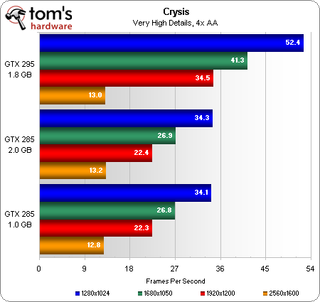GeForce GTX 285 Gets 2 GB: Gigabyte's GV-N285OC-2GI
Benchmark Results: Crysis
Though it’s fairly old, Crysis remains one of the most demanding games in our benchmark suite. We’ve even given up on testing 8x anti-aliasing (AA), since it simply hasn’t functioned at 2560x1600 on our SLI-equipped systems, but 4x AA still applies a fairly significant load.

Only the SLI enhanced dual-GPU GeForce GTX 295 can play Crysis smoothly at high details and a 2560x1600 resolution. Both GTX 285 models are similarly playable at 1920x1200, and we have yet to see a benefit for the 2 GB card’s added RAM.

GPU power is seriously strained at Very High details, with the GTX 295 playing smoothly at a maximum 1920x1200 resolution. The GeForce GTX 285’s drop to 1280x1024 for playability, and we've yet to see a benefit to the 2 GB card’s added RAM.

Enabling anti-aliasing at 4x finally allows the 2 GB card to emerge a leader, but only at the unplayable 2560x1600 resolution. The dual-GPU GTX 295 drops to 1680x1050 for its maximum smooth setting, while the single-GPU GTX 285’s are too slow at all resolutions.
Stay on the Cutting Edge
Join the experts who read Tom's Hardware for the inside track on enthusiast PC tech news — and have for over 25 years. We'll send breaking news and in-depth reviews of CPUs, GPUs, AI, maker hardware and more straight to your inbox.
Current page: Benchmark Results: Crysis
Prev Page Test Settings Next Page Benchmark Results: Far Cry 2-
twisted politiks ive had EVGA's GTX 285 for about two months now, nothing new in the memory departmentReply -
rambo117 wow... that was quite pointless, i was really expecting a good article but it was the same numbers basically, why not just have a single page with the average gains with 2gb vs 1gb (which was completely nonexistent anyways)Reply
-
astrodudepsu Well, all I can say is good try. Not some of your best work, but worth exploring nonetheless.Reply -
Crashman astrodudepsuWell, all I can say is good try. Not some of your best work, but worth exploring nonetheless.Reply
Tom's Hardware was hoping to find more 2560x1600 scenarios where the 2GB advantage would play out. When very few advantages were found, Tom's did the honest thing and published the numbers anyway.
I think you can take a lot from this article. I just spoke to a guy who asked "2GB or water cooling?" when looking at cards of the same price. He has a powerful water cooling loop, so the answer was easy. -
one-shot I think it is a great article. Too often people approach me thinking a larger frame buffer means extra performance. Actually, just recently a co-worker wanted to get a GTX 285 with 2GB of VRAM. Great article, keep it up!Reply -
SpadeM Just a quick question: Since the GTX285 is a high range card, those the same "1GB is enough" rule apply to mid range/low end cards?Reply
PS: I'm thinking slower GPU might benefit from more memory -
astrodudepsu CrashmanTom's Hardware was hoping to find more 2560x1600 scenarios where the 2GB advantage would play out. When very few advantages were found, Tom's did the honest thing and published the numbers anyway.Reply
Which is why I said it was worth exploring. I realize you wouldn't do all this work and NOT publish your results, as mundane as they may be. -
rambo117 it was quite informative and worth exploring like astrodude said. just wish that it was a little more 'exciting'.. idk, maybe an sli 2gb vs 1gb will prove to be possibley more interesting.Reply -
Hellbound If a card is going to cost $350-$400, and perform as much as %50 less than the car that costs $500....get the $500 card. You are already spending an insane amount for a card, might as well go all the way. As for me, I'm waiting for the DX11 cards to come out.Reply -
Crashman rambo117it was quite informative and worth exploring like astrodude said. just wish that it was a little more 'exciting'.. idk, maybe an sli 2gb vs 1gb will prove to be possibley more interesting.Reply
Three-way would have been best, but there's just not enough samples to go around.
Most Popular


